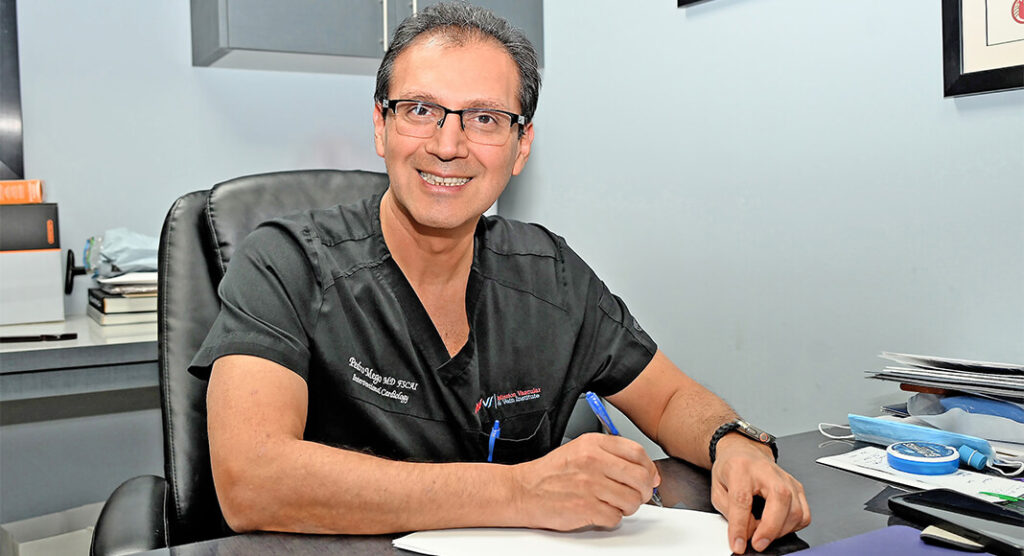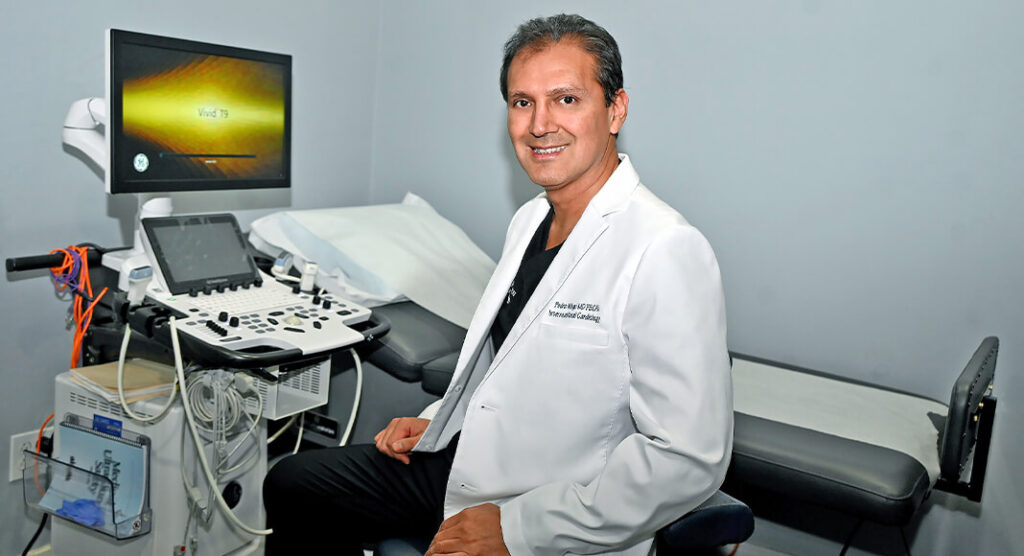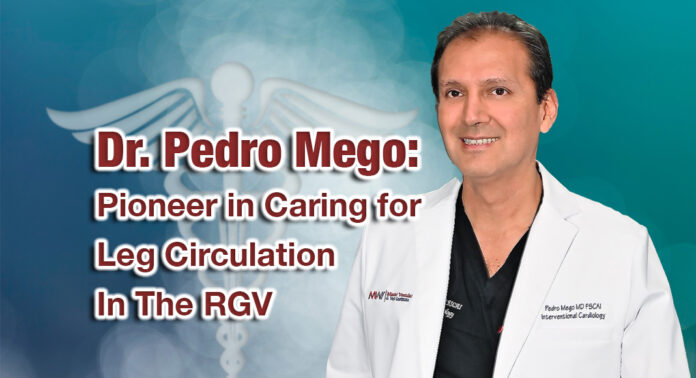Mega Doctor News
By Roberto Hugo González
When it comes to specialized care for circulation problems in the legs, Dr. Pedro Mego stands as a leading figure. A board-certified Interventional Cardiologist and Endovascular Specialist of the American Board of Vascular Medicine (ABVM), Dr. Mego has dedicated his career to treating Peripheral Artery Disease (PAD) and Chronic Venous Disease (CVD), conditions that affect the arteries and veins in the legs. His journey into this field began in 2005, and since then, he has transformed vascular care in South Texas, making advanced treatments accessible to patients in need.

From Heart Care to Leg Circulation
Dr. Mego’s foundation lies in cardiology, but his work has evolved into a specialized focus on leg circulation. Reflecting on his path, he explains:
“By training, I am a board-certified cardiologist and interventional cardiologist, but now I am fully dedicated to treating the circulation in the legs.”
During his Interventional Cardiology training in Arkansas, Dr. Mego received specialized training in peripheral artery disease. This experience led him to realize the pressing need for such care in South Texas, where high rates of obesity and diabetes contribute to severe leg circulation issues.
“When I came in 2005, I was the only interventional cardiologist trained in peripheral artery disease,” he recalls. “Because of the need for this kind of treatment in the Valley, I began to like treating patients with PAD. A few doctors were doing it, but somewhat limited.”
Over time, his passion for addressing these critical conditions grew, leading him to build a practice that became a regional hub for vascular care. Together with his brother, Dr. Carlos Mego, and colleague Dr. Subbarao Yarra, he developed a reputation for aggressive and effective treatment of PAD.

Addressing a Growing Epidemic
The prevalence of PAD in South Texas is deeply tied to lifestyle and health challenges. As Dr. Mego notes, “When I came to the Valley, I was aware of the high incidence of obesity and diabetes. But what I did not anticipate was the very high prevalence of amputation.”
In 2010, McAllen, Texas, was reported to have one of the highest amputation rates in the U.S. due to untreated PAD. This stark reality has driven Dr. Mego to raise awareness about the condition and the importance of seeking second opinions before resorting to amputation.
“Absolutely, yes,” Dr. Mego emphasizes. “If someone has been diagnosed with PAD and told there’s no other option but amputation, they should seek a second opinion.”
Understanding Peripheral Artery Disease
PAD is a condition where cholesterol plaques build up in the arteries, blocking blood flow to the legs. Dr. Mego explains the basics in simple terms:
“Plaque formation is a combination of fats and inflammatory material that deposit inside the arteries. It can block both big arteries and small ones.”
The symptoms of PAD vary depending on the severity:
- Early Stages: Many patients are asymptomatic, though blockages may already exist.
- Progression: Atypical symptoms may include cramps, tiredness, or coldness in the legs.
- A distinctive sign is claudication, or calf pain while walking, which eases with rest.
- Advanced Stages: When symptoms are present at rest, it is called Critical Limb Ischemia (CLI). Patients may experience pain at rest (frequently, they wake up with pain while sleeping), ulcers that won’t heal, or gangrene, which is death tissue.
If untreated, PAD can lead to CLI, a dangerous condition that is associated with an elevated risk of amputation, heart attack, stroke, and death.
“Unfortunately, when we see patients with advanced PAD, it’s very common that one or more arteries are completely blocked, making the treatment challenged,” says Dr. Mego.
Endovascular Specialist provides Minimally Invasive Solutions
Thanks to technological advancements, PAD treatment no longer requires major surgery. Dr. Mego’s approach is based on minimally invasive procedures that offer faster recovery and fewer risks.
“We use catheters, wires, balloons, lasers, and other devices to clean the arteries without any scars,” he explains. “The procedure takes about an hour and is done under conscious sedation. Patients go home the same day.”
For patients with kidney disease, he notes, “We can use CO2 gas instead of iodine, reducing the risk of worsening kidney function.”
Dr. Mego’s clinic also treats venous diseases, such as varicose veins, vein clots, leg pain, and chronic swelling, which can lead to ulcers. Minimally invasive techniques are effective and significantly reduce healing times for these conditions.
“Venous ulcers that used to take years to heal now often close in just one or two months,” he says.
Prevention: A Simple but Powerful Message
While advanced treatments are a lifeline for many, Dr. Mego stresses the importance of prevention through lifestyle changes. He encourages patients to adopt healthier habits to reduce the risk of PAD and venous diseases.
“Obesity and diabetes play a huge role in these conditions,” he says. “But prevention is ideal. A healthy diet, walking, and staying active can make a big difference.”
He offers practical advice: “You don’t need to go to a gym or play sports. Just walk. Park farther from the store, get a dog and walk with your mascot, visit a friend on foot — look for excuses to stay active.”
Dr. Mego is deeply committed to serving his community. He leads the Mission Vascular & Vein Institute, specializing in diagnosing and treating PAD, chronic venous disease, and other circulation-related conditions.
The institute operates from Mission, Texas, with recent expansions to Edinburg and plans to open a new location in Weslaco in January 2025. Depending on their insurance plans, patients can access comprehensive care through referrals or self-appointments.
“We’re excited to expand our services,” says Dr. Mego. “Our goal is to make these treatments accessible to as many people as possible.”
Dr. Mego’s dedication goes beyond treatment. He advocates for early diagnosis, second opinions, and community awareness. He believes that addressing PAD and venous disease improves individual lives and reduces the burden on families and society.
“If someone has an ulcer, a blackened toe, or is told they need an amputation, they should know that treatment options are available,” he says. “These conditions affect not just the patient but the entire family.”
Dr. Pedro Mego’s work is transforming vascular care in South Texas. Through innovative treatments, preventive education, and a patient-first approach, he offers hope to those suffering from PAD and venous diseases. His message is clear: early diagnosis, lifestyle changes, controlling risk factors and minimally invasive procedures can make a difference.
“I’ve seen too many patients come to us thinking there’s no hope,” he reflects. “But with the right care, we can improve their quality of life—and often save their limbs.”
For more information or to schedule a consultation, contact the Mission Vascular & Vein Institute at (956) 997-6000 or visit their website. https://www.missionvascularinstitute.com.
See related story:










